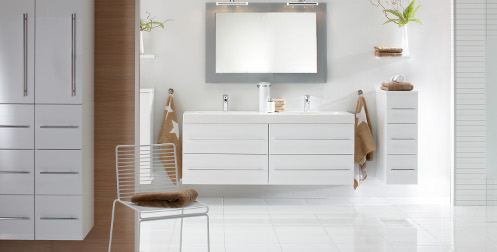
Handicap Accessible Bathroom Remodeling Tips
Average Rating
Rate This Article
Most Popular Bathroom Remodeling Cities
Related Articles
Bathroom Remodeling Bathroom Remodeling Costs Bathroom Vanities and Cabinets Bathroom Faucets and Sinks Comparing the Top 5 Bathroom Flooring Options Installing a Bathroom Vanity: The Smart Way Showers and Shower Doors Bathroom Toilets Bathroom Plumbing Fixtures The Bathroom of the Future: New Innovations in Bathroom Remodeling Top 10 Bathroom Remodeling TrendsWhen a loved one is no longer fully mobile, the discussion often revolves around relocating to a more accommodating environment. This does not need to be the case. With some careful planning, the old home can be remodeled to accommodate the less mobile, and those with wheelchairs. The transition will always be a difficult one, but a contractor can advise you on where to begin. Some rooms are easier to tackle than others, but navigating a bathroom once wheelchair bound can be the worst kind of challenge. It is of the utmost importance that the restroom be easily accessible to everyone. Not surprisingly, remodeling bathrooms for handicapped access is one of the most requested of accessible construction services.
Handicap Accessible Doors
Naturally, doors should be widened by several inches to accommodate the width of a wheelchair. This is easier in some locations than others. In many situations, it is possible to widen the doorframe during a renovation. However, space limitations may prevent this. If so, it is possible to install offset door hinges. Easy to install, these mechanisms swing the door clear of the opening, adding an additional two inches of space. It is also beneficial to install a lever handle, and make it so that no more than 5 pounds of weight are needed to open the door.
Handicap Accessible Bathtubs
Often, bathtubs can simply be removed and replaced with a shower, which can be custom built to fit your particular space requirements. Roll in showers are the ideal for wheel chair users, because they require minimal effort on the part of the resident. They do, however, require a significant amount of effort to install, because the drain needs to be lowered. If shower conversion proves too difficult, the bathtub can be revamped and outfitted with new safety measures. Installing grab bars will ease the transition from the chair into the tub. Providing a seat in the tub will relieve individuals from the burden of having to lower themselves all the way to the bottom.
Handicap Accessible Toilet
The toilet seat should be raised to allow for an easy transfer from a wheelchair. Every individual has different needs, but somewhere between 17 and 19 inches high should be adequate. Installing grab bars is a necessity to ensure safe passage onto the toilet seat.
Handicap Accessible Sinks
It will probably be necessary to lower the sink for easier access. The cabinet area that usually sits below a bathroom sink can be removed and relocated to allow for knee space. Once again, lever handles on the sink will make it easier to operate. Depending on your preference, it is possible to install a temperature regulator, making it impossible for the water to reach uncomfortable or dangerous levels of heat.
A comfortable bathroom is one of the things your home your own. Remodeling is always an arduous task, but if the result will make your life easier, it is a worthwhile endeavor.
Learn more handicap accessible bathroom remodeling tips or schedule a free, on-site assessment and estimate from a local pro contractor by contacting us today.





